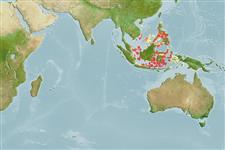Classification / Names
आम नाम | उपशब्द | Catalog of Fishes(वर्ग, प्रजाति) | ITIS | CoL | WoRMS | Cloffa
>
Ophidiiformes (Cusk eels) >
Dinematichthyidae (Viviparous brotula)
Etymology: Ungusurculus: Name from Latin words 'ungulus' (= claw) and 'surculus' (= grapevine tendril), refers to the functional analogy with the pseudoclaspers and the specific shape of the inner pseudoclasper; philippinensis: Named for the Philippine Islands, its area of distribution.
More on authors: Schwarzhans & Møller.
Environment: milieu / climate zone / depth range / distribution range
पारिस्थितिकी
समुद्री प्रवाल-भित्ति संयुक्त; गहराई सीमा 5 - 10 m (Ref. 90102). Tropical
Western Pacific: Philippines.
आकार / वज़न / Age
Maturity: Lm ? range ? - ? cm
Max length : 4.8 cm SL पुल्लिंग / अलिंग; (Ref. 76869); 5.2 cm SL (female)
Short description
पहचान कुंजी | आकृति विज्ञान | मौरफोमैटरिक्स
पृष्ठीय सौफट रेज़ (सम्पूर्ण) : 78 - 87; ऐनल सौफट रेज़: 54 - 66; जानवरों की रीड़ का जोड़: 42 - 44. This species is distinct with the following characters: D 78-87, A 54-66, D/A 22-27, V in D 2.2-2.4; vertebrae 12-13+29-32=42-44; anterior nostril located 1/4 the distance from upper lip to aggregate distance to anterior margin of eye; free pseudoclaspers 2 pairs, outer pseudoclasper wing-shaped with broad base and distally slightly widened supporter without anterior hook, the inner one moderately long, with widened base, distally with 2 inward directed strong spines; cheeks with 5-6 scale rows on upper part and 3-4 rows on lower; no upper preopercular pore; otolith moderately elongate, its length to height is 2.0-2.1, pointed anterior and posterior tips, short sulcus with ventral indentation at joining of ostium and cauda, partly fused colliculi, its centre anterior to centre of otolith, inclined about 10°, otolith length to sulcus length is 2.0-2.1 (Ref. 76869).
Inhabitant of reef crevices, cryptic and solitary (Ref 90102).
Life cycle and mating behavior
परिपक्व अवधि | पुनरुत्पत्ति | मछलीऔ का अंडे देना | अंडे | Fecundity | लार्वा
Schwarzhans, W. and P.R. Møller, 2007. Review of the Dinematichthyini (Teleostei: Bythitidae) of the Indo-west Pacific. Part III. Beaglichthys, Brosmolus, Monothrix and eight new genera with description of 20 new species. The Beagle, Records of the Museums and Art Galleries of the Northern Territory 23:29-110. (Ref. 76869)
IUCN Red List Status (Ref. 130435: Version 2024-1)
Human uses
मात्स्यिकी: कोई रुचि बग़ैर
साधन
Special reports
Download XML
इंटरनेट स्रोत
Estimates based on models
Preferred temperature (Ref.
123201): 28.1 - 29.2, mean 28.8 °C (based on 560 cells).
Phylogenetic diversity index (Ref.
82804): PD
50 = 0.5156 [Uniqueness, from 0.5 = low to 2.0 = high].
Bayesian length-weight: a=0.00389 (0.00180 - 0.00842), b=3.12 (2.94 - 3.30), in cm total length, based on all LWR estimates for this body shape (Ref.
93245).
Trophic level (Ref.
69278): 3.2 ±0.5 se; based on size and trophs of closest relatives
Fishing Vulnerability (Ref.
59153): Low vulnerability (10 of 100).
